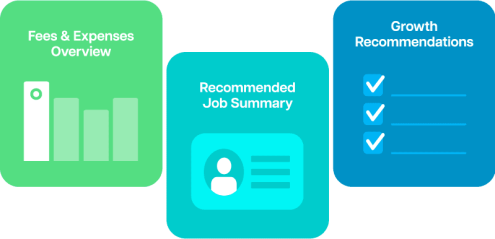Navigating the Skills Shortage in Australia

Australia is facing one of its most significant skills shortage in recent years, with industries such as technology, healthcare, and construction struggling to fill critical roles. As businesses attempt to scale and maintain operations, the inability to find and retain skilled workers is creating bottlenecks that can slow growth and compromise competitive advantage.
This calls for proactive measures that go beyond traditional recruitment for C-suite leaders. Upskilling, embracing remote work, and strategic partnerships can help them be resilient in an uncertain economy while filling the gap of talent.
In this article, we will outline eight key tactics that will help businesses thrive during a skills shortage, continue innovating, remain competitive, and build a future-ready workforce.
Tactic 1: Upskilling and Reskilling Your Existing Workforce

The best way to address a skills shortage is to invest in the talent you already have. Upskilling and reskilling your existing workforce can fill critical gaps, boost employee engagement, and retain top performers who are eager to grow with your organization. To successfully upskill and reskill your workforce, consider these key strategies:
1. Prioritise Professional Development Programs
Provide your employees with access to relevant training, certifications, and workshops—whether in leadership, technical skills, or customer service—ensures they develop the expertise your business needs. With options like in-house training, external courses, and online platforms such as Coursera or LinkedIn Learning, you can create flexible development plans tailored to individual growth.”
2. Promote Internal Mobility
Encourage internal career progression by filling new roles with current employees who have demonstrated potential. This also gives an opportunity for loyalty to be fostered, and valuable company knowledge stays within your organisation.
For example, employees working in customer service roles may be upskilled to handle client account management or data analytics, thus giving them new career opportunities while meeting business needs.
3. Personalised Learning Pathways
For best results, ensure that you have learning pathways customized to the employee’s career goals. Conduct skill assessments and performance reviews to identify areas of knowledge gaps and recommend the right upskilling options.
By improving the skill set of your team, you’re not only filling critical gaps but also strengthening employee satisfaction and retention by demonstrating a commitment to their growth
4. Leverage Mentorship and Cross-Training
Fostering collaboration by putting employees with mentors who can guide them in the acquisition of new skills is a great way to build agility and resilience across teams. Cross-training initiatives, whereby employees learn distinct roles across departments, are also an effective way to achieve this. Your finance team might benefit from being exposed to sales operations, and your marketing team might get insights from collaborating with customer support teams.
5. The Benefits of Upskilling and Reskilling
Investing in upskilling and reskilling your workforce offers long-term benefits beyond just filling immediate skill gaps. Training existing employees is often more cost-effective than recruiting and onboarding new talent, while also enabling them to adapt more quickly to new responsibilities since they are already familiar with your company’s processes and culture.
Additionally, providing growth opportunities boosts retention, as employees who feel valued and supported are more likely to stay, reducing turnover during competitive hiring periods. In a constantly evolving business landscape, empowering employees with the skills to grow ensures your organization remains agile and future-proof.
Tactic 2: Embracing Flexible Work Models

In an era where flexibility ranks as the main priority for talent, flexible models of work bring a game-change to attract talent and retain skills. Hybrid or fully remote roles can also help Australian companies reach a lot more talent around the world – without being limited geographically – or improve employee job satisfaction, subsequently leading to increases in productivity and reductions in turnover.
1. Attract a Broader Talent Pool
A very office-bound, rigid approach to work may prevent access to highly skilled professionals. If your business is in an area experiencing a local talent drought, embracing remote work means that your business can tap into candidates from regional Australia or even global markets and find the expertise your organization needs, no matter where it is. Flexible roles can also attract employees who prioritize work-life balance, like parents, caregivers, or professionals looking for the freedom to do things their own way.
2. Boost Retention with Work-Life Balance
Employees who have work life balance are a lot more likely to remain with organizations that allow work-life flexibility. Businesses can allow features including:
- Flexible hours: Allowing employees to adjust their schedules to meet personal needs.
- Remote or hybrid work: Giving employees the option to work from home or choose office days.
The results are a boost in retention and avoidance of burnout, especially in industries that have tight deadlines and high-pressure environments.
3. Strengthen Collaboration with Digital Tools
Flexible work is freeing, but strong and effective communication and collaboration can be affected. Here are some digital tools capable of encouraging productivity and connectivity among teams while having a flexible work set-up:
- Video conferencing platforms (Zoom, Microsoft Teams) for virtual meetings.
- Project management tools (Asana, Trello, Slack) to track tasks and deadlines.
- Shared workspaces (Google Workspace, Notion) for document collaboration.
By implementing the right technology and effective methods of communication among remote teams, they can remain cohesive, engaged, and aligned with company goals.
4. Cost Savings and Office Optimisation
Flexible work patterns create opportunities for operational cost savings. Hybrid or remote work structures help reduce expenses related to rent, utilities, and maintenance. Many businesses now opt for smaller, collaboration-focused office spaces instead of traditional full-time, desk-based facilities, often incorporating “hot-desking” to accommodate occasional on-site employees efficiently.
5. Case Example: Success with Flexible Work
Many Australian companies, especially in the tech, consulting, and finance sectors, have been successful with flexible work models. For instance, Atlassian has continued to have a ”work from anywhere” policy, which has enabled them to retain top-tier talent across the globe while maintaining work-life balance and high-performance levels.
Adopting flexible work models is not just a short-term solution to skills shortages—it is a long-term strategy that demonstrates trust in your workforce and positions your business as an employer of choice. By creating an environment where employees have the freedom to work in ways that suit their lifestyles, your business will gain a significant edge in the competitive talent market.
Tactic 3: Leveraging Offshore and Outsourced Talent

During skills shortages, many Australian businesses are compensating for talent gaps by tapping into offshore and outsourced talent like Staff Domain. High-quality, cost-effective support across administrations, customer service, technical, and creative work can be provided using offshore virtual assistants and specialised professionals in regions like the Philippines and South Africa. This outsourcing strategy lifts the efficiency of business operations and puts the business in a better competitive position without having to delay or incur the costs incurred with hiring locally.
1. Access a Wider Talent Pool Without Geographic Limitations
Offshore outsourcing will open access to a world of talent where talent is typically unattainable in local markets. Whether you want some administrative professional expertise, bookkeeping, or graphic design services, highly experienced experts in such places as the Philippines and South Africa are readily available to deliver high-quality work at costs far below market standards.
These markets are known for their established outsourcing ecosystems, making it easy for Australian businesses to find qualified talent who can seamlessly integrate into their workflows.
2. Cost Savings Without Compromising on Quality
Hiring global talent through cost-effective outsourcing solutions for Australian businesses is a highly efficient alternative to hiring local full-time employees. By leveraging outsourcing, businesses can access skilled professionals at competitive rates, thanks to the lower cost of living in established outsourcing hubs. This approach enables companies to overcome skills shortages while optimising their budgets and maintaining high-quality work standards.
For example:
- Administrative support roles from the Philippines may cost AUD $7–$15 per hour, compared to $30–$40 for local staff.
- Creative and specialised services such as copywriting, legal assistance, or data analysis in South Africa can cost between AUD $20–$35 per hour—far more affordable than domestic salaries.
Check out this salary guide.
With these cost efficiencies, businesses can reallocate savings to growth initiatives, training, or expanding their service offerings.
3. Improve Flexibility with On-Demand Support
Outsourcing also lets companies easily scale in and out based on fluctuations during seasons or on specific projects. Instead of hiring full-time staff in-house, you can hire offshore talent part-time or for individual projects. This arrangement ensures you are only paying for services that you need such as temporary support for a marketing campaign or a long-term virtual assistant for ongoing administrative tasks.
4. Time Zone Alignment for Real-Time Collaboration
Another significant benefit of outsourcing to countries such as the Philippines and South Africa is that they are compatible with time zones.
- The Philippines (AEST – 2 hours): Virtual assistants can easily align with Australian working hours for real-time collaboration.
- South Africa (GMT +2): Offers overlapping working hours, especially for businesses operating across multiple time zones (e.g., Perth and Europe), enabling global teams to collaborate effectively.
This time zone alignment ensures faster response times and enhanced productivity, making it easy for offshore teams to stay coordinated with your local operations.
5. Maintain Quality with the Right Outsourcing Partner
To ensure high-quality work, it is essential to choose an outsourcing partner or hiring platform that vets its professionals carefully. Partnering with reputable platforms ensures you are hiring dependable professionals who meet your business needs and quality standards.
Case Example: The Impact of Offshore Talent on Australian Businesses
Many Australian startups and SMEs have grown rapidly through outsourcing support functions. For example, a Melbourne-based e-commerce business reduced its operational costs by 40% when it outsourced customer support and inventory data management to a team of Filipino VAs. That allowed the company to reinvest those savings in digital marketing and new product development, which, within 12 months, pushed revenue up 25%.
Leveraging offshore and outsourced talent helps Australian businesses in times of local skills shortages and provides them with a competitive edge. With access to global talent, businesses can stay operationally efficient, scale rapidly, and allow their core team to focus on higher-value work.
Tactic 4: Strengthening Employer Branding and Recruitment Strategy

In a competitive market, it is not just about posting job ads; you need to position your organisation as an employer of choice. A strong employer brand that reflects the values, culture, and growth opportunities within the company can make a business stand out and appeal to top talent.
By refining the recruitment strategy and highlighting strengths, you can capture the interest of highly skilled candidates even in the face of a skills shortage.
1. Build and Promote Your Employer Brand
Employer brand reflects how current and potential employees perceive your organisation. To strengthen your brand:
- Share Employee Success Stories: Highlight employee achievements, career progression, and testimonials to demonstrate how you invest in your team.
- Leverage social media: Highlight your company culture, milestones, and team events through platforms such as LinkedIn and Instagram.
- Highlight Work Perks and Values: Promote benefits like flexible work arrangements, professional development programs, and wellness initiatives.
Creating authentic and engaging content humanises your brand and makes skilled professionals more likely to consider your company.
2. Leverage LinkedIn for Strategic Talent Outreach
LinkedIn has become a critical platform for recruiting passive candidates—professionals who may not be actively job-hunting but are open to the right opportunity. Here is how to optimise your LinkedIn strategy:
- Engage with Industry Groups: Participate in relevant LinkedIn communities to connect with professionals in your field.
- Employee Advocacy: Encourage your employees to share job posts and company updates to expand your reach.
- Personalised Messaging: When reaching out to candidates, craft personalised messages that highlight how your company aligns with their career goals and values.
This initiative-taking approach allows you to reach top-tier candidates who may not respond to traditional job ads.
3. Build Partnerships with Universities and Training Organisations
Collaborate with universities and training organizations to strengthen your recruitment pipeline. Establishing partnerships with educational institutions and industry bodies can help you connect with emerging talent and future professionals. Universities, Technical and Further Education (TAFE), and training organisation partnerships can allow you to reach emerging talent in high-demand areas such as IT, healthcare, and engineering.
- Graduate Recruitment Programs: Establish internship or graduate programs that build a pipeline of skilled early-career professionals.
- Industry Events and Job Fairs: Attend career expos and participate in networking events to connect with recent graduates and experienced job seekers.
These partnerships not only increase your visibility but also demonstrate your commitment to nurturing future talent.
4. Create Competitive Job Offers
In a highly competitive labour market, offering attractive compensation and benefits is essential to securing top talent. Today, competitive compensation goes beyond just salary—it includes rewards, incentives, and perks that differentiate your business from the competition.
Consider offering:
- Performance Bonuses: Reward high-performing employees with bonuses or incentives tied to key milestones.
- Flexible Benefits: Let employees choose benefits that suit their needs, such as additional annual leave, wellness stipends, or professional development budgets.
- Career Development Plans: Provide clear pathways for career growth, including promotions and leadership opportunities.
When candidates feel that your company cares about their long-term development and well-being, they are more likely to choose you over competing offers.
5. Measure and Optimise Your Recruitment Efforts
Track the effectiveness of your recruitment strategy by monitoring key performance indicators (KPIs), such as:
- Time to Hire: The average time it takes to fill open positions.
- Offer Acceptance Rate: The percentage of candidates who accept your job offers.
- Employee Retention Rate: How long new hires stay with the company.
By analysing these metrics, you can identify areas for improvement and adjust your recruitment strategy accordingly.
Success Example: Standing Out in a Competitive Job Market
A Brisbane-based fintech company strengthened its employer brand by sharing employee case studies on LinkedIn and hosting “Ask Me Anything” sessions for prospective hires. By highlighting its commitment to flexible work, professional growth, and team culture, the company attracted 40% more qualified applicants within six months, even amid a nationwide skills shortage in tech roles.
A well-executed employer branding and recruitment strategy positions your company as an attractive destination for skilled professionals. By building a strong reputation and refining your talent acquisition approach, you can stand out in a crowded market and secure the talent you need to grow and succeed.
Tactic 5: Implementing Technology to Boost Efficiency

In the event of a skills shortage, technology can help bridge the resource gap and improve productivity. By automating repetitive tasks and streamlining workflows, businesses can take some workload off their existing teams and allow their skilled professionals to focus on higher-value responsibilities. It is possible to make your operations more efficient by using the right tools and software to get more out of fewer resources.
1. Automate Routine and Repetitive Tasks
One of the easiest ways to increase productivity is by streamlining more time-consuming tasks using automation. Automation tools can be readily applied to repetitive workflows in the following areas:
- Customer support: Chatbots and automated ticketing systems for initial customer inquiries.
- HR processes: Automated onboarding workflows, leave requests, and payroll processing.
- Marketing tasks: Email automation, social media scheduling, and lead generation tracking.
By automating these processes, you can free up your team’s time to focus on tasks that require strategic thinking and creativity.
2. Leverage AI and Machine Learning for Data-Driven Insights
Artificial intelligence (AI) and machine learning (ML) can support decision-making by processing large volumes of data and identifying patterns. Businesses can use AI tools for:
- Predictive analytics: Forecasting demand, customer trends, or operational bottlenecks.
- Sales support: AI-powered CRM tools that recommend follow-ups and prioritise leads.
- Customer service: Sentiment analysis to detect patterns in customer feedback and improve service.
These tools can function as “force multipliers” for your teams, allowing them to make faster and more informed decisions.
3. Enhance Collaboration with Digital Workspaces
With flexible and hybrid work models becoming the norm, digital collaboration tools are essential for keeping remote teams connected and productive. Platforms such as Slack, Microsoft Teams, and Asana enable teams to collaborate on projects in real-time, while cloud-based solutions like Google Workspace and Notion allow for seamless document sharing and version control.
Implementing the right digital workspaces can improve communication, reduce workflow inefficiencies, and prevent project delays—especially when teams are distributed across various locations.
4. Improve Recruitment and Onboarding with HR Tech
HR technology can help businesses fill roles more efficiently and onboard new hires faster. Tools like LinkedIn Talent Insights, BambooHR, and Workable simplify the recruitment process by:
- Automating job postings and applicant tracking.
- Streamlining interview scheduling and feedback collection.
- Managing onboarding checklists and paperwork digitally.
HR tech platforms also provide valuable data on hiring trends, helping you make smarter decisions when adjusting recruitment strategies.
5. Invest in Cybersecurity Tools to Protect Remote Operations
As your business becomes more reliant on digital tools and remote work, cybersecurity is critical. Data breaches and cyberattacks can disrupt operations and erode trust. Implementing robust security measures such as:
- Two-factor authentication (2FA) to protect sensitive accounts.
- VPNs and endpoint protection to secure remote access.
- Data backup and recovery solutions to ensure business continuity in the event of an attack.
Investment in cybersecurity technology will give your business immunity towards disruption, letting your remote workers work with maximum confidence and peace of mind safely.
6. Monitor Productivity with Performance Tracking Tools
Performance tracking tools can provide insights into how your teams are managing their workloads and help identify potential areas for improvement. Tools such as Hubstaff, Time Doctor, or Toggl Track enable managers to monitor time spent on tasks, helping to optimise workloads without micromanaging.
These tools can support transparent communication and help identify burnout risks, ensuring that teams remain productive without becoming overstretched.
Case Example: Tech-Driven Efficiency in a Sydney Consultancy
A Sydney-based consulting firm implemented AI-powered workflow tools and CRM automation to streamline its project management and client communications. By automating routine client updates and using predictive analytics to track project milestones, the firm reduced manual admin hours by 30% and doubled its client-handling capacity—all without increasing its headcount.
Investing in the right technology not only addresses immediate skill shortages but also builds operational resilience for the long term. By embracing automation, AI, and collaboration tools, Australian businesses can scale their operations, improve efficiency, and empower their workforce to deliver maximum impact.
Tactic 6: Fostering a Collaborative Company Culture

In a skills shortage, having a positive, collaborative company culture is a key differentiator in attracting and retaining top talent. Skilled professionals are likely to be loyal to organisations that make them feel valued, connected, and supported. A strong culture also promotes cross-functional teamwork and innovation, allowing your business to do more with the talent you already have.
1. Prioritise Open Communication and Transparency
A collaborative culture originates with clear, open communication. By leadership genuinely communicating company goals, progress updates, and key challenges to employees, employees will view the company’s mission more personally. Here is how to encourage more openness:
- Regular team updates: Host weekly or monthly meetings to keep everyone informed.
- Leadership visibility: Encourage leaders to be approachable and open to feedback.
- Anonymous feedback channels: Create a safe space for employees to share ideas or concerns.
When employees know that their voices are heard and their contributions matter, they are more likely to engage and collaborate effectively.
2. Encourage Cross-Departmental Collaboration
Silos within organizations can work against productivity and innovation. Promote cross-functional teams to collaborate on key projects, build working relationships, and promote knowledge sharing. The ways through which cross-department collaboration can be encouraged include:
- Project-based workgroups: Assign employees from different departments to collaborate on specific initiatives.
- “Lunch and Learn” sessions: Host informal presentations where teams can share their expertise with other departments.
- Internal job shadowing: Allow employees to spend time observing other departments to understand how their roles intersect.
This cross-pollination of ideas helps teams work more cohesively and fosters problem-solving from diverse perspectives.
3. Recognise and Celebrate Achievements
Recognition goes a long way in motivating teams and reinforcing collaboration. Celebrating individual and team achievements fosters a sense of purpose and appreciation. Consider:
- Shout-outs in team meetings: Publicly acknowledging contributions during team check-ins.
- Peer recognition programs: Implementing platforms where employees can recognise each other’s work.
- Incentives for collaboration: Offering rewards for cross-team projects that achieve significant milestones.
Recognition does not always have to be monetary—a simple “thank you” or a company-wide spotlight can have a significant impact on morale and engagement.
4. Provide Opportunities for Social Connection
Remote and hybrid work models can make it challenging for teams to build rapport. To maintain a collaborative culture, prioritise virtual and in-person social activities that foster relationships. Ideas include:
- Virtual team-building events: Online quizzes, trivia, or team games.
- Regular in-person meetups: Organise quarterly team lunches or off-site days for employees in the same region.
- Well-being initiatives: Encourage activities such as mindfulness programs or fitness challenges to support mental health and social bonding.
When teams feel a sense of belonging, they are more likely to work collaboratively and support each other during demanding periods.
5. Create Clear Roles and Responsibilities
Clarity on who should take responsibility for what drives collaboration. Clear roles and accountability frameworks prevent projects from stalling due to overlapping duties or confusion. Get your teams to:
- Use project management tools (e.g., Asana, Monday.com) to assign tasks and track progress.
- Share clear team charters outlining goals, deliverables, and individual responsibilities.
- Conduct regular check-ins to align timelines and resolve blockers early.
Clear expectations create a more structured environment, where employees can collaborate without stepping on each other’s toes.
Case Example: Collaborative Culture at a Melbourne Tech Startup
A Melbourne-based tech startup struggling with high turnover in the time of tech talent shortage initiated a “Team Connect” that included cross-departmental brainstorming sessions and quarterly social events. By encouraging teamwork, openness, and frequent acknowledgment, the company increased its employee engagement score by 40% within nine months while reducing attrition by 30%.
One of the most powerful approaches to dealing with a skills shortage is to create a collaborative culture within your organization. Building trust, encouraging teamwork, and developing rapport can help an environment nurture that which you already have in the form of talent and attract new talent as people are enthusiastic to join your firm.
Tactic 7: Partnering with Industry Groups and Training Organisations

Building strategic partnerships with industry groups and training organisations can be a highly effective way to address the talent gap during a skills shortage. By aligning with educational institutions, professional associations, and government-backed training programs, businesses can gain access to skilled candidates while contributing to the long-term development of the talent pipeline.
1. Collaborate with Universities, TAFEs, and Training Providers
Building strategic relationships with industry associations and training institutions not only helps bridge the talent gap during skills shortages but also strengthens workforce planning, innovation, and business growth. These partnerships can support multiple talent strategies, from recruitment and upskilling to employer branding and leadership development. By working closely with higher education institutions, professional associations, and government-endorsed training schemes, businesses can access emerging talent, influence curriculum development, and future-proof their workforce.
- Internship and Graduate Programs: Establish structured programs that offer direct experience to students and early-career professionals, helping you build a pipeline of future hires.
- Guest Lectures and Workshops: Send company representatives to speak at educational events to highlight your organisation as a leader in your industry and attract top graduates.
- Co-designed Courses: Collaborate with training providers to create courses aligned with the specific skills your industry needs, ensuring graduates are job ready.
- Scholarships and Sponsorships: Support students in critical skill areas through scholarships or sponsorship programs. This not only builds goodwill but also helps secure early access to top talent who may later join your workforce.
- Research and Innovation Partnerships: Work with universities and industry bodies on research initiatives that drive technological advancements, process improvements, or sector-wide innovations. These collaborations can position your company at the forefront of industry trends.
- Talent Development Pipelines: Establish direct pathways for students and trainees to transition into full-time roles through structured learning-to-work programs, mentorship initiatives, and leadership development tracks.
These partnerships strengthen your recruitment efforts and position your company as an employer that invests in professional development.
2. Engage with Professional Associations and Industry Bodies
Industry groups and professional associations often have access to highly skilled professionals who are looking for new opportunities or professional growth. By building relationships with these organisations, you can expand your recruitment network.
- Networking Events and Job Fairs: Attend industry job expos and conferences to connect with mid-level and senior professionals.
- Recruitment Partnerships: Collaborate with industry bodies to create targeted job boards or participate in mentorship programs where you can connect with promising candidates.
By incorporating your business in the education and training system, you’re not only strengthening your recruitment efforts but also build a sustainable talent pipeline, enhancing your industry influence, and future-proofing your workforce.
3. Participate in Government-Backed Training and Employment Programs
Other businesses that invest in training and apprenticeships are normally supported by the government and subsidies. Programs like Jobs and Skills Australia and Boosting Apprenticeships Commencements in Australia offer funding for companies that take on apprentices and trainees in critical sectors.
- Access Wage Subsidies: some government programs may give incentives to those hiring and training employees in key areas.
- Support Workforce Transition: Partner with reskilling programs designed to help workers transition from declining industries (e.g., retail) into growing sectors such as technology, health, and trades.
These programs not only provide access to up-and-coming talent but also support long-term workforce planning for your business.
4. Build Relationships with Registered Training Organisations (RTOs)
RTOs play a crucial role in delivering industry-specific training and upskilling programs. By partnering with RTOs, you can:
- Co-design Upskilling Initiatives: Work with RTOs to tailor training programs that suit your organisation’s unique requirements.
- Access Custom Talent Pools: Collaborate with RTOs to recruit skilled graduates from courses focused on technical and in-demand roles, such as data analysis, cybersecurity, or logistics.
By working closely with RTOs, you can ensure your future hires have practical, job-ready skills that match your business needs.
5. Develop Community and Regional Partnerships
For businesses operating in regional Australia, forming partnerships with local community organisations can help you connect with talent in remote areas. These partnerships may include:
- Indigenous Employment Programs: Collaborate with initiatives focused on increasing employment opportunities for Indigenous Australians.
- Regional Upskilling Grants: Leverage local grants aimed at workforce development in regional areas.
These partnerships not only address immediate workforce needs but also demonstrate your commitment to supporting local communities and fostering inclusivity.
Case Example: Regional Partnership Success in Construction
A construction firm based in Queensland, who was experiencing a shortage of skilled labour, entered a partnership with a local TAFE and RTO to develop a tailored apprenticeship program in civil engineering. The company accessed government programs, which provided it with wage subsidies and training support, to fill critical positions. Within 18 months, the program reduced the lead time taken to recruit people by 50% and improved the company’s reputation as a top regional employer. The proactive way to manage the skills shortage is through partnering with educational institutions, training organizations, and industry bodies. By investing in strategic alliances, your business will be strategically positioned to gain access to skilled talent, enhance recruitment efforts, and contribute to building a sustainable workforce for the future.
Tactic 8: Implementing Talent Retention and Development Strategies
In a skills shortage, retaining your star performers is not less is more important than having new recruits to the business. High employee turnover can bleed finances, interrupt operations, and injure team morale, so the emphasis on robust retention and development programmes can build allegiance, and job pride, and commit your skilled personnel to long-term success in your company.
1. Conduct Stay Interviews to Identify Employee Needs
Unlike exit interviews, which occur after an employee has decided to leave, stay interviews are proactive conversations designed to understand what motivates your employees and what may cause them to leave.
- Ask employees what aspects of their role they enjoy most and where they see opportunities for growth.
- Use the feedback to make informed changes, such as improving work-life balance, offering career development opportunities, or refining management practices.
These interviews can reveal valuable insights into potential retention risks and help you implement solutions before it is too late.
2. Offer Clear Career Progression Paths
Employees are more likely to stay when they see opportunities for advancement within your organisation. Provide transparent career progression frameworks that outline:
- Skills and competencies required for promotions.
- Timelines and milestones for professional development.
- Mentorship programs to guide employees as they prepare for new roles.
When employees know what is required to grow within the company, they are more likely to feel motivated and engaged.
3. Invest in Employee Well-being Initiatives
Supporting your employees’ mental and physical well-being is crucial for retaining talent—especially during high-demand periods. Consider implementing initiatives such as:
- Employee Assistance Programs (EAPs): Providing access to confidential counselling and support services.
- Wellness Stipends: Offering financial support for health-related expenses, such as gym memberships or mindfulness apps.
- Flexible Work Policies: Encouraging time off and offering “no-meeting days” to reduce burnout and improve focus.
A healthy workforce is more productive, resilient, and likely to remain loyal to your business.
4. Recognise and Reward High Performance
Recognition and rewards can have a significant impact on employee morale and retention. Ensure that your recognition programs are consistent and meaningful by:
- Tying rewards to performance goals: Recognise employees who meet or exceed KPIs, complete challenging projects, or contribute innovative ideas.
- Offering personalised rewards: Tailor rewards to what your employees value—whether it is professional development courses, additional leave days, or performance bonuses.
- Celebrating milestones: Acknowledge work anniversaries, promotions, and key project completions to foster a sense of belonging.
Employees who feel valued and appreciated are far more likely to remain loyal to your business.
5. Create a Culture of Continuous Feedback and Growth
Continuous feedback and development discussions can keep employees engaged in their work and motivated to better themselves. Implement a performance management system that emphasizes:
- Regular one-on-one check-ins between managers and team members.
- Constructive feedback loops that focus on strengths, as well as areas for improvement.
- Development plans that include access to new training, stretch assignments, and mentorship.
When feedback is delivered consistently and constructively, employees gain clarity on how they can grow and contribute to the company’s goals.
6. Encourage Internal Mobility
Sometimes, employees seek new challenges—not necessarily outside your company, but in different departments or roles. By encouraging internal mobility, you can retain talent by offering cross-department transfers or role changes.
- Implement internal job boards to make employees aware of open roles before posting externally.
- Offer skill assessments and reskilling programs to help employees transition to new departments.
Internal mobility not only helps retain valuable employees but also reduces the costs and time associated with external recruitment.
Case Example: Talent Retention in an Australian Consulting Firm
A Sydney-based consulting firm facing high turnover implemented a “Talent Growth Pathway” program that provided employees with access to personalised learning plans, mentorship, and quarterly feedback sessions. The firm also introduced quarterly “recognition awards” and well-being programs to reduce burnout. After 12 months, the company saw a 25% reduction in voluntary attrition and a significant boost in employee engagement scores.
Businesses can compensate for the scarcity of skills in the talent marketplace by investing heavily in retention and development programs to create a sustainable, high-employee-engagement workforce. Making sure to concentrate on growth, recognition, and employee well-being leads to having top talent loyal and driving business momentum.
Conclusion: Building Resilience Amidst the Skills Shortage
The current skills shortage challenges most businesses across different industries in Australia. However, if the right strategies are in place, businesses can overcome talent gaps, foster growth, and remain competitive. Focusing on a combination of upskilling, flexible work models, outsourcing, and strategic partnerships allows you to not only address immediate workforce needs but also future proof your organisation against ongoing labour market shifts.
Key takeaways from these eight tactics for success include:
- Investing in your existing workforce through reskilling and career progression opportunities.
- Embracing flexibility to attract and retain top talent.
- Leveraging offshore talent to fill resource gaps and boost efficiency.
- Strengthening employer branding to stand out in a competitive recruitment market.
- Utilising technology to enhance productivity and streamline workflows.
- Fostering collaboration to improve employee satisfaction and teamwork.
- Partnering with industry organisations to tap into new talent pipelines.
- Prioritising retention strategies to keep your high performers engaged and committed.
By adopting a comprehensive approach that combines these key tactics, your business will be well-positioned to build resilience and thrive—even in the face of a skills shortage.
Now is the time for C-suite leaders to act, implementing long-term talent acquisition and retention strategies that empower their teams and position their organisations for sustainable growth.
Staff Domain‘s offshore outsourcing solutions connect your business to a highly experienced global talent pool for game-changing results. Effortlessly manage your offshore workforce with our comprehensive compliance, payroll, and HR support, and benefit from fixed, transparent pricing in your local currency. Contact us today or schedule a meeting with our sales team to quickly source the right offshore team for your business
FAQs About Overcoming a Skills Shortage
1. What is causing the current skills shortage in Australia?
The skills shortage in Australia is driven by several factors, including the impact of the COVID-19 pandemic on workforce mobility, the ageing population, and growing demand in key industries such as healthcare, construction, and technology. Additionally, competition for top talent has intensified as businesses expand their digital capabilities and adopt flexible work models.
2. How can businesses retain top talent during a skills shortage?
Retaining top talent requires a focus on employee well-being, career growth, and recognition. Key strategies include:
- Offering clear career progression paths and personalised development plans.
- Implementing flexible work policies to support work-life balance.
- Recognising and rewarding high performance with meaningful incentives.
Engaged and appreciated employees are more likely to remain loyal to the organisation, even during competitive hiring periods.
3. Is outsourcing a sustainable solution to the skills shortage?
Yes, outsourcing can be a sustainable solution when managed correctly. Offshore virtual assistants and remote professionals can provide skilled support in areas such as administration, customer service, and specialised technical roles. Partnering with reputable outsourcing platforms ensures consistent quality and allows businesses to scale their workforce cost-effectively without delays in recruitment.
4. How can technology help mitigate the impact of a skills shortage?
Technology can help businesses boost productivity and fill resource gaps by automating repetitive tasks, improving workflow efficiency, and enabling data-driven decision-making. Tools such as project management software, AI-powered CRMs, and HR platforms streamline operations, allowing skilled professionals to focus on higher-value work.
5. What roles do partnerships with educational institutions play in addressing the talent gap?
Partnerships with universities, TAFEs, and registered training organisations (RTOs) help businesses access emerging talent and co-design industry-specific training programs. Graduate recruitment programs, internships, and collaborations on upskilling initiatives can create a steady talent pipeline, equipping new graduates with the practical skills needed for in-demand roles.









